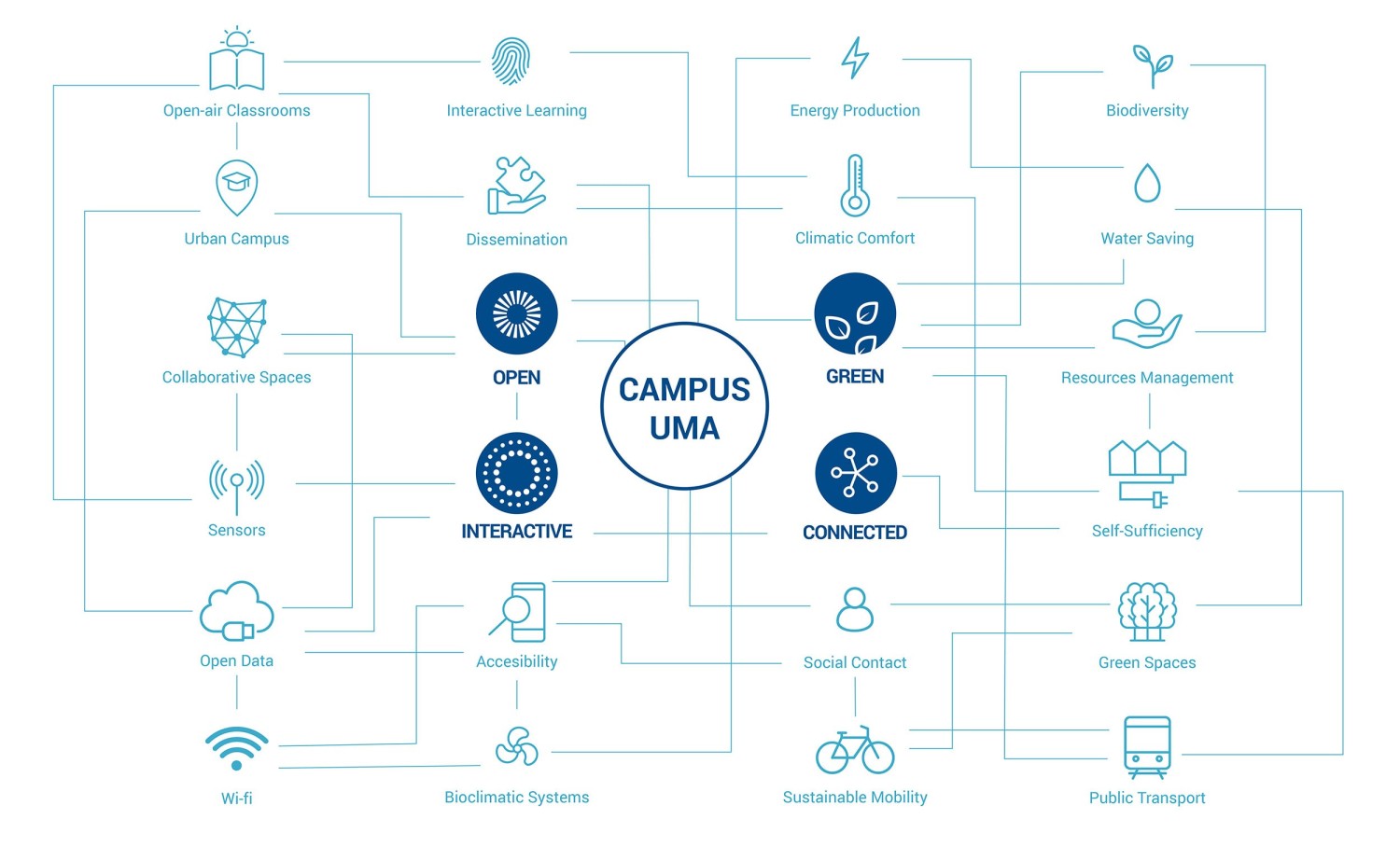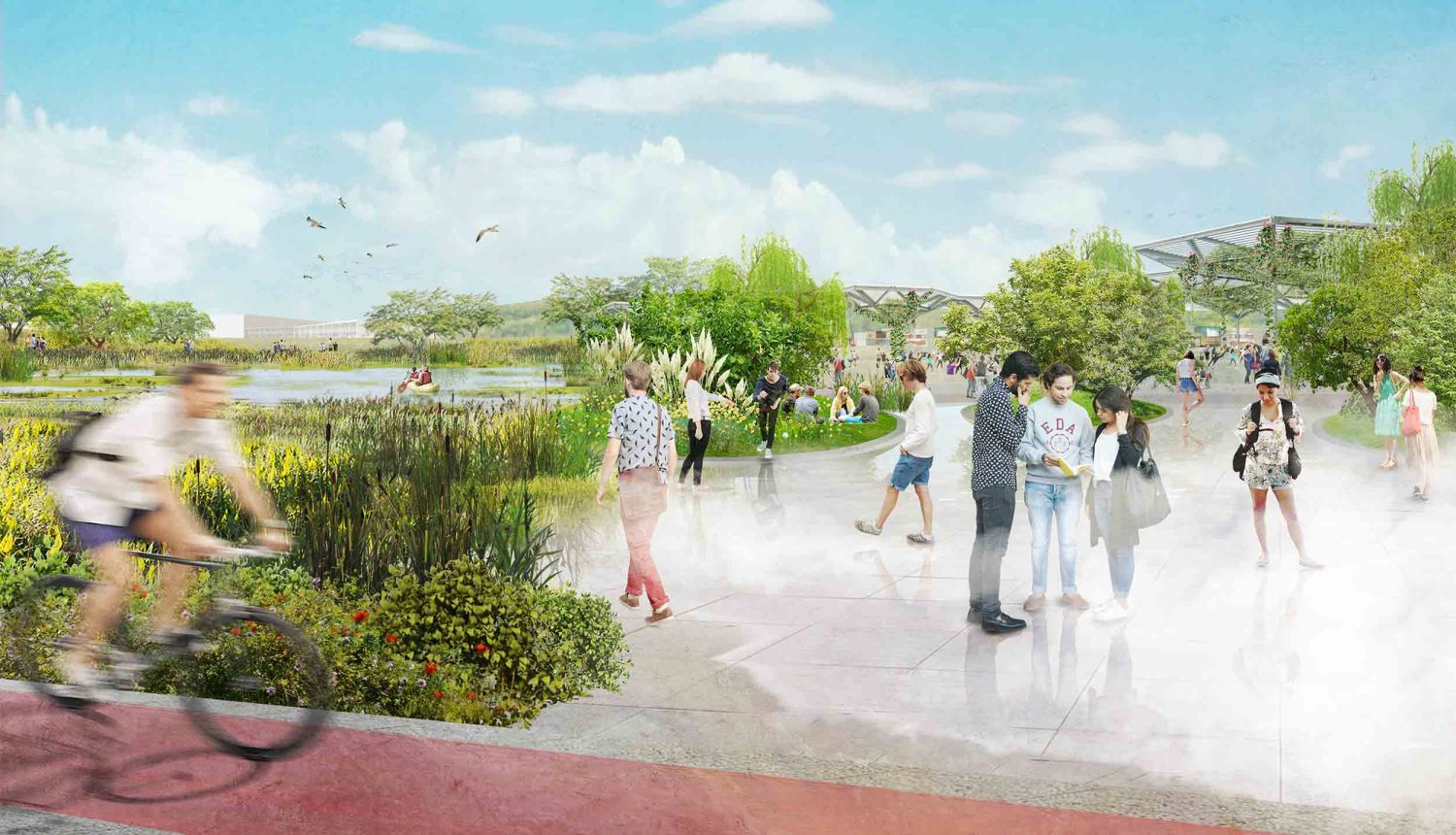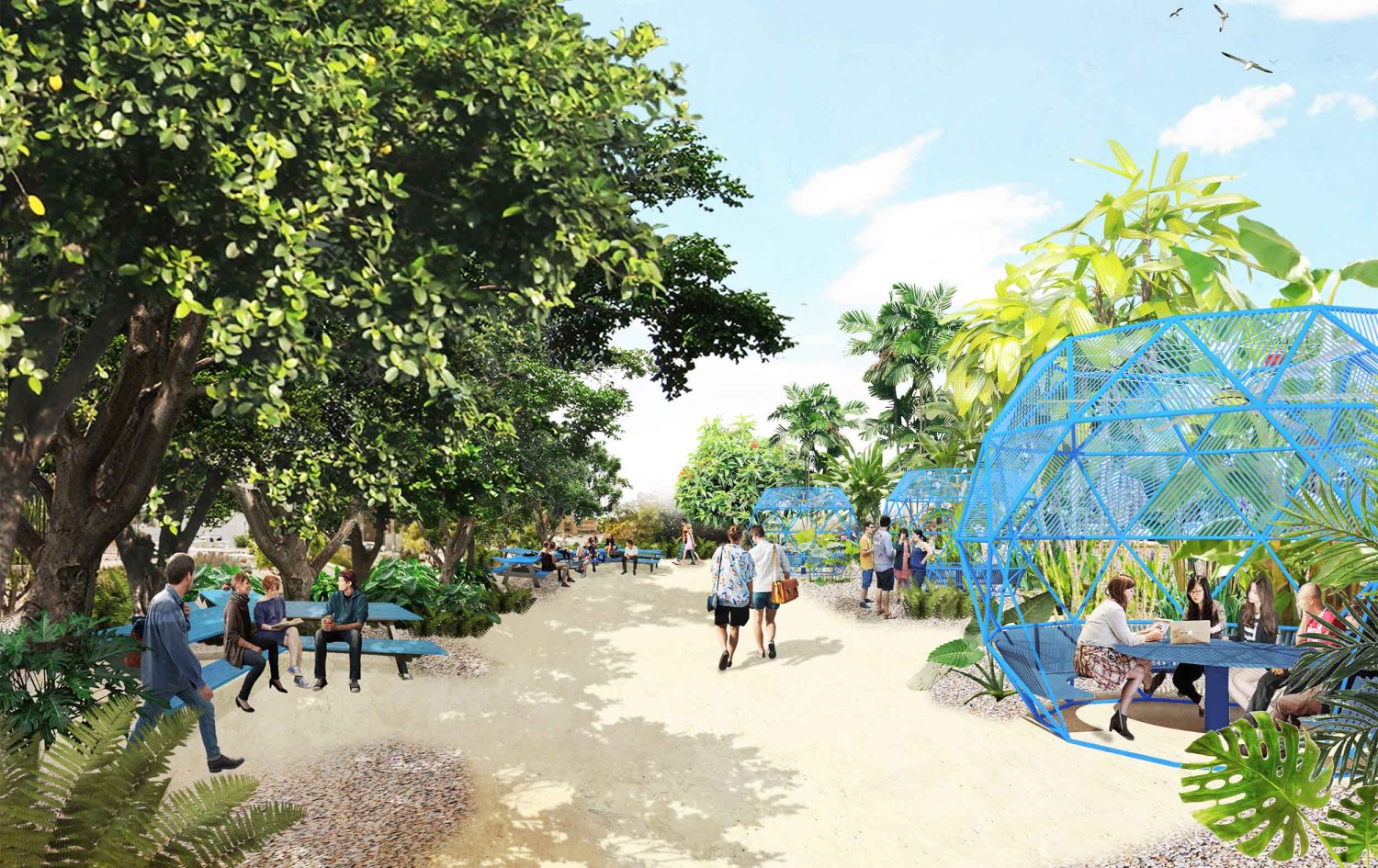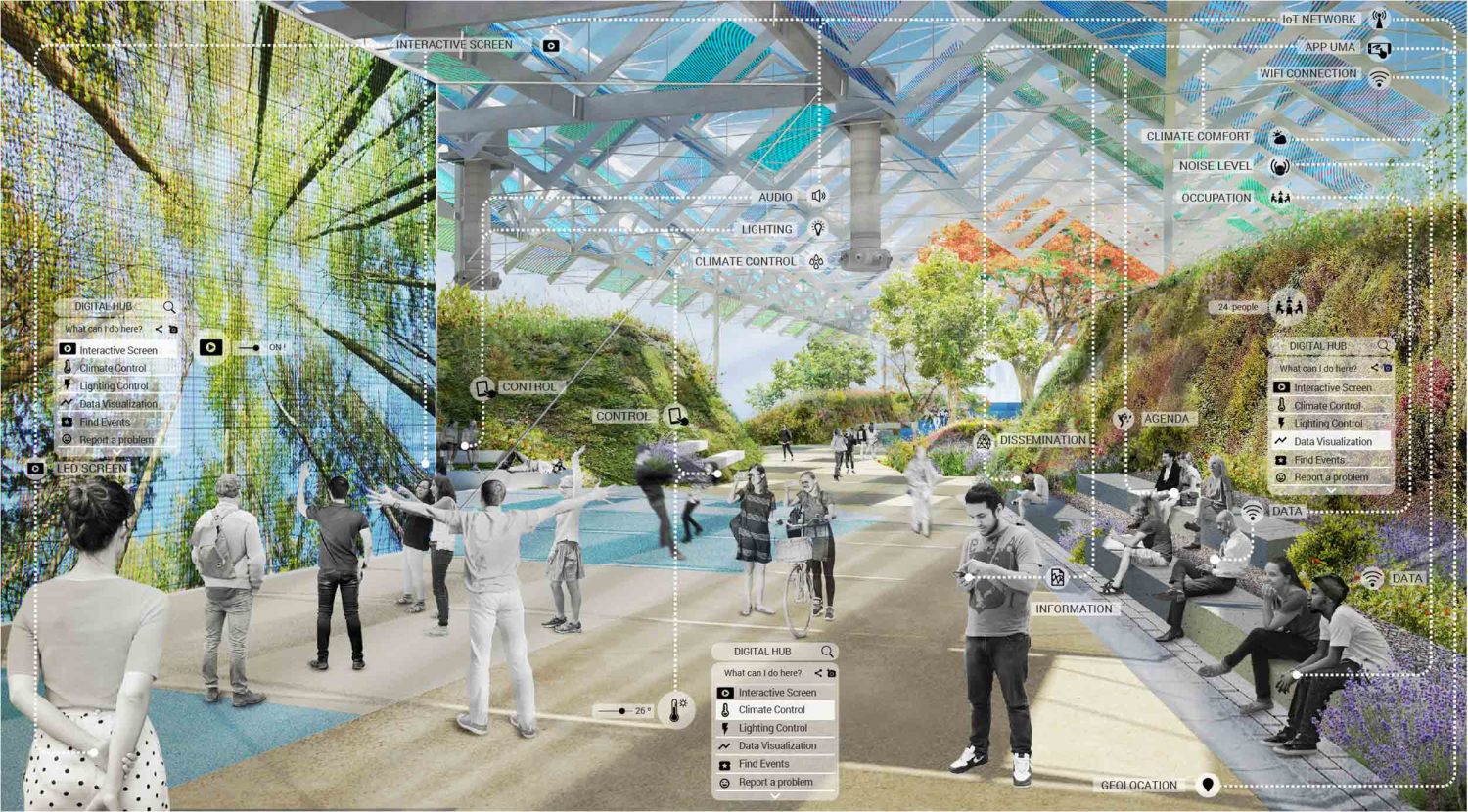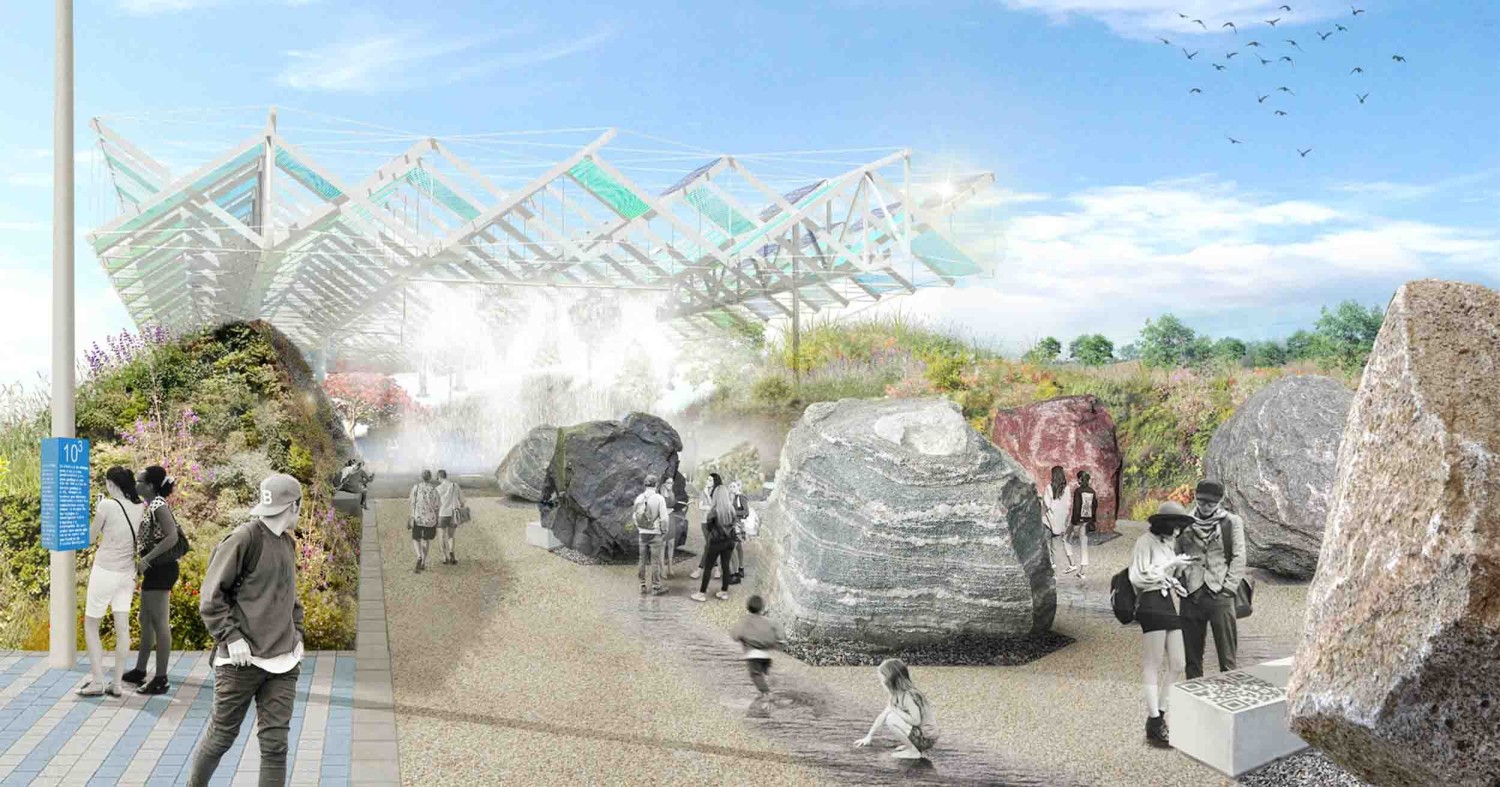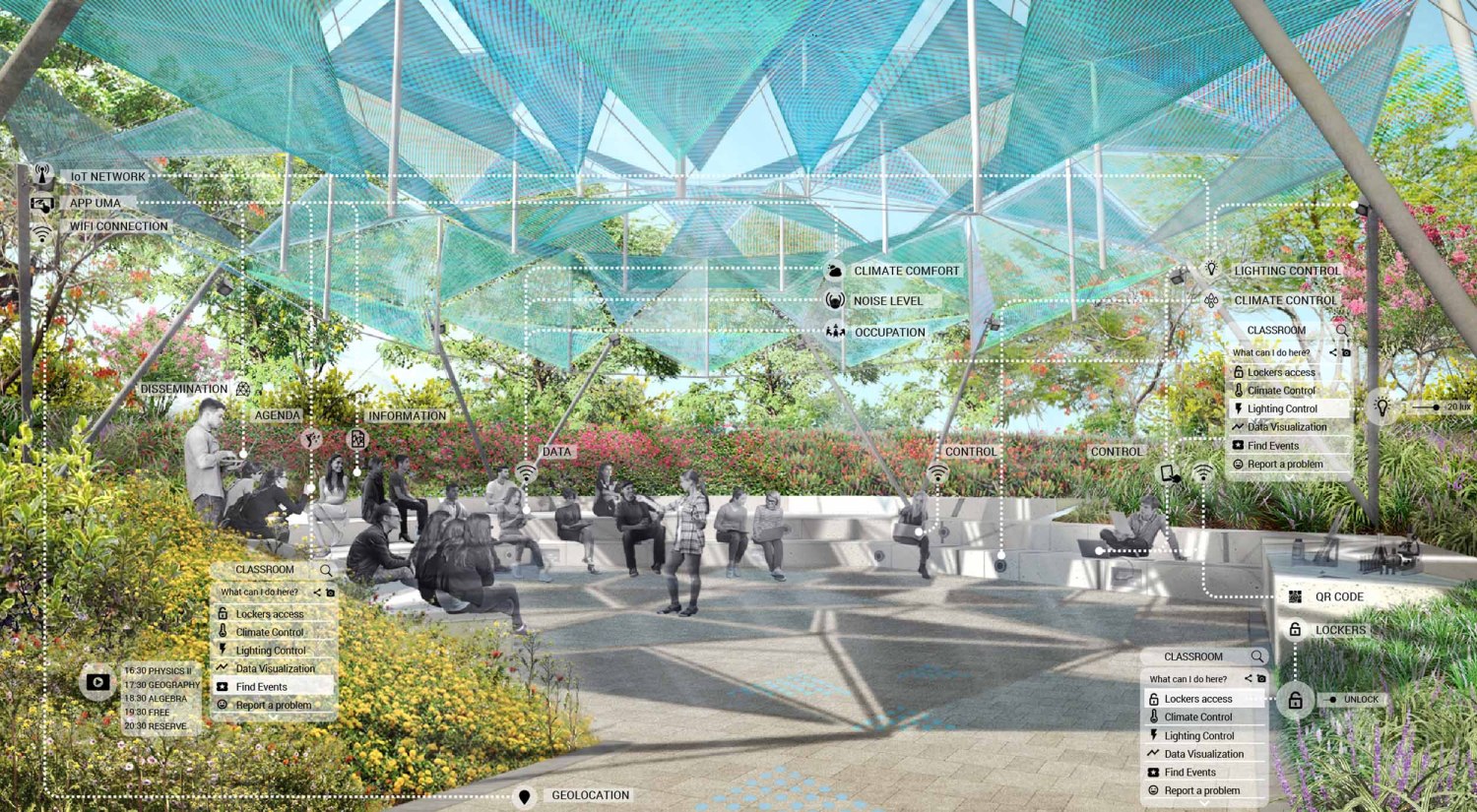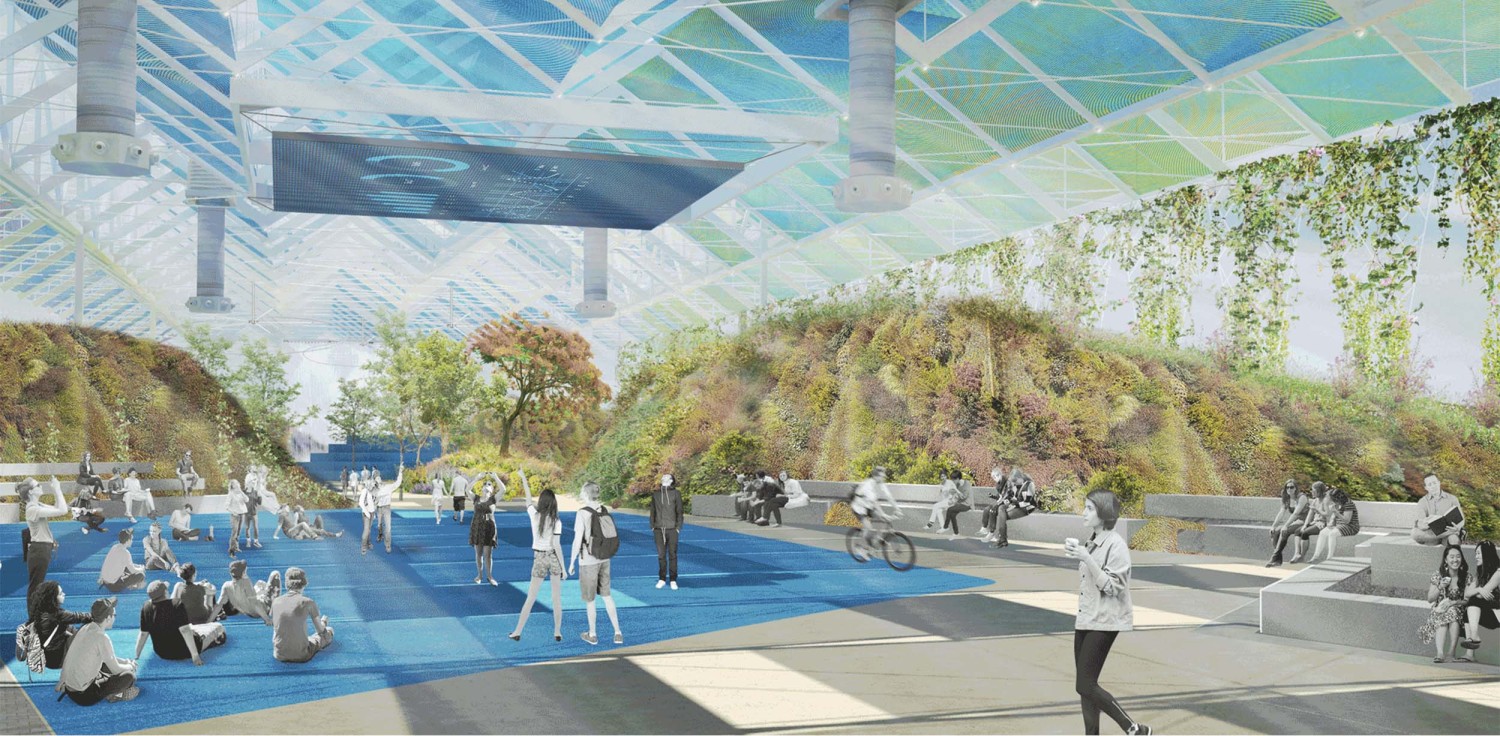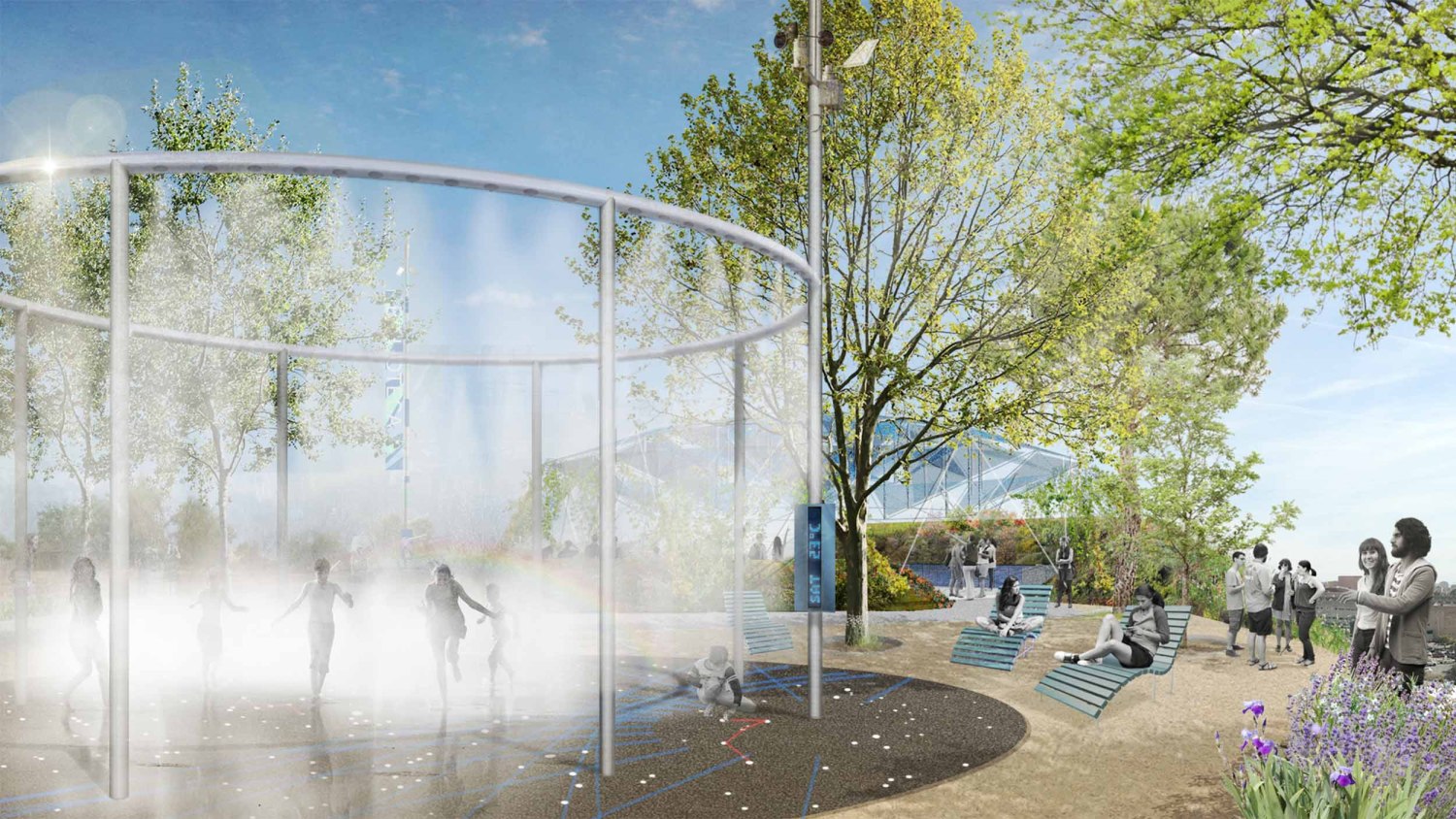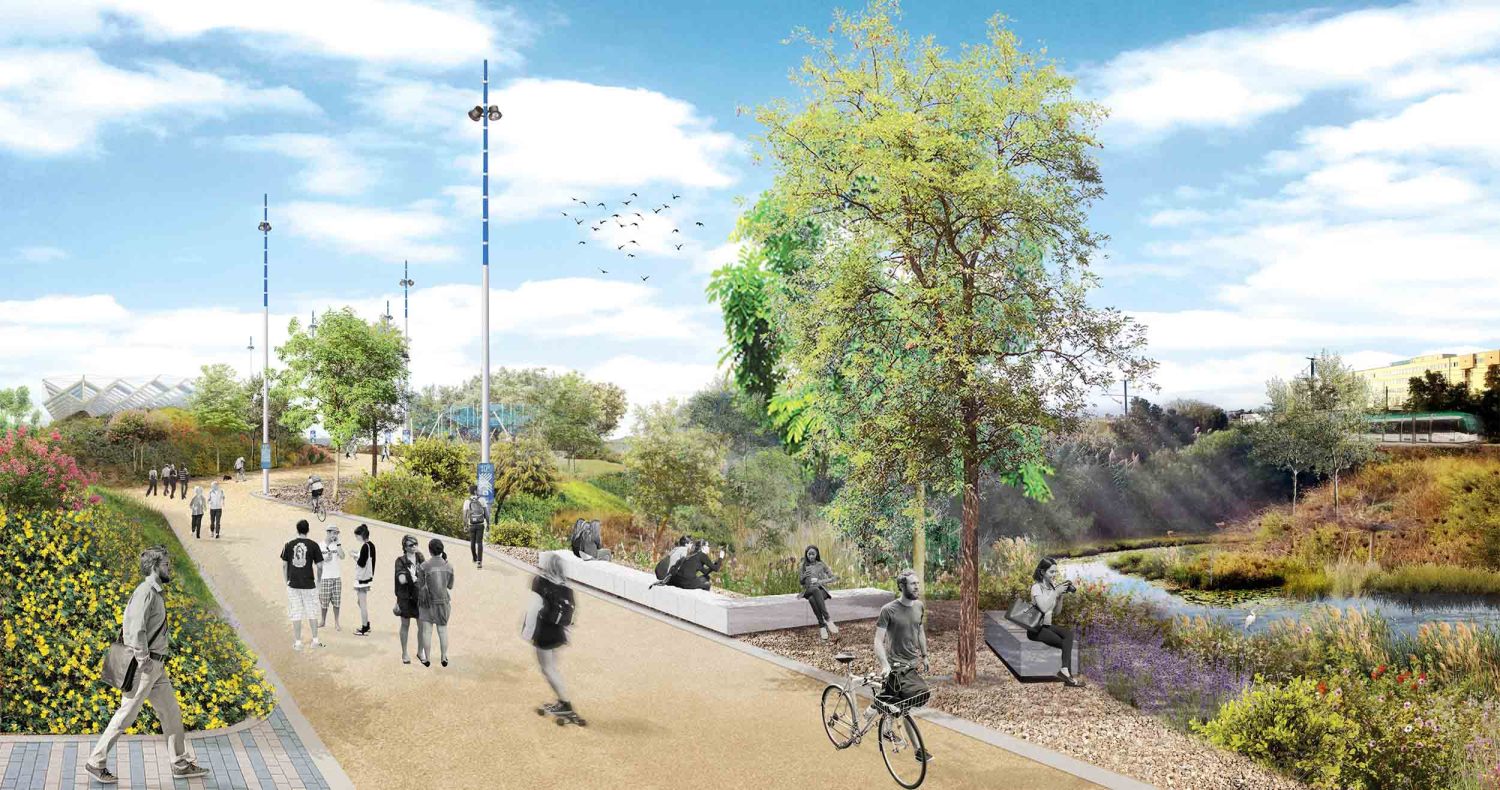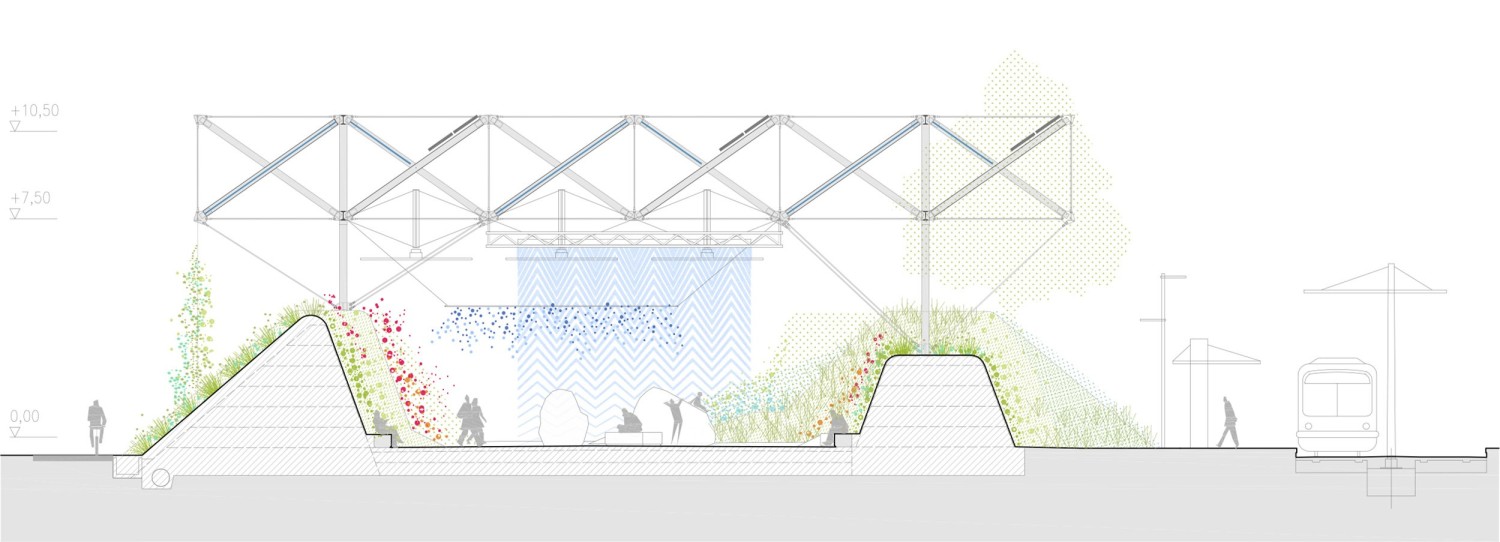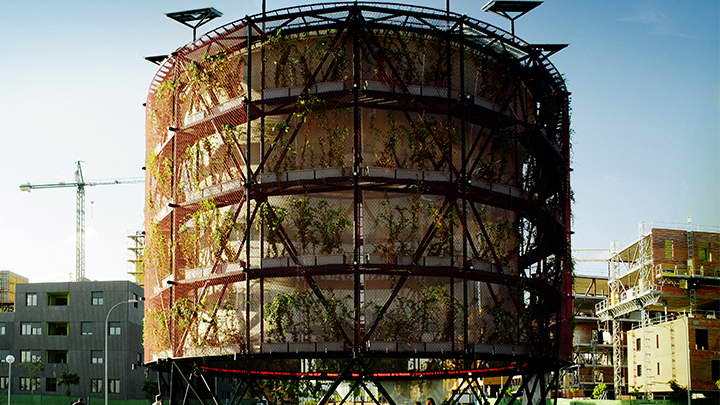| 公司: | ECOSISTEMA URBANO | 类型: | 景观 |
|---|---|---|---|
| 地区: | 西班牙 | 标签: | 校园 |
一个互联、开放、互动、绿色的校园
一个智能的自然空间,正能量平衡,生态舒适
A connected, open, interactive and green campus.An intelligent natural space, with positive energy balance and bioclimatic comfort.
Malaga University Campus
a natural and digital environment to create an augmented academic and urban experience
Ecosistema Urbano在2016年获得马拉加大学(University of Malaga)的公开招标后,设计了路易斯巴斯德大道(Louis Pasteur Boulevard)和蒂蒂诺斯大学(Teatinos University)校园主要公共空间的景观规划项目,总表面积为21公顷(52 ac)。第一期工程的总表面积为7公顷(17 ac),预计于2020年12月完成。
Ecosistema Urbano, after being awarded a public tender promoted by the University of Malaga in 2016, has developed the Landscape Planning Project for the Louis Pasteur Boulevard and the main public spaces of the Teatinos University Campus, with a total surface area of 21 Ha (52 ac). The completion of the construction of the first phase, comprising a total surface area of 7 Ha (17 ac), is planned for December 2020.
该项目符合马拉加大学的战略:开放和创新。为了加强公共空间内的学术和社交功能,设计创造了一个有吸引力和舒适的自然环境,并结合了科学技术,使得自然环境与数字之间得到互动。
The project, in line with the University of Malaga's strategies, develops the concept for an open and innovative campus. In order to enhance the academic and social functions within public spaces, the design creates an attractive and comfortable natural environment, as well as incorporates technology that allows for a new atmosphere of interaction between the physical and digital environments.
路易巴斯德大道,通过基础设施建设,将一个未被充分利用的大区域完全包围。该区域通过结合新的空间和景观特征以及清晰的规划,转变为大学校园的主要空间,同时改善了气候舒适度和连接性。
The Louis Pasteur Boulevard project regenerates a large and underused area, surrounded by infrastructure. This area transforms into the main space of the university campus by combining new spatial and landscape features with highly articulated programmes that improve its climatic comfort and connectivity.
设计方案旨在实现双重目标,第一,使日常大学活动——教学、学习、会议或阅读得以在公共空间进行,第二,为城市提供新的绿色基础设施。
The design proposal aims to achieve the dual goal of enabling everyday university life activities — teaching, studying, meeting, or reading—to take place in public spaces, while providing a new green infrastructure for the city.
通过仔细研究校园的四种生活方式,得到以下四个互补战略:
Four ways of rethinking a campus.Following four complementary strategies:
● 互联校园:这一战略创造了一个完整的城市布局,通过连接不同的设施,将大学与周围的环境,以及整个城市连接起来。
● Connected Campus: This strategy creates a complete urban layout, through connecting different facilities and opening the university to its immediate surroundings, as well as the whole city, focusing primarily on public transportation and pedestrian areas.
● 绿色校园:通过全球可持续管理战略,创建一条生态路线,恢复绿化空间,增强现有绿色空间的潜力,如橄榄园或植物园。
● Green Campus: Creates an ecological route that, through a global strategy of sustainable management, recovers space and enhances the potential of existing green spaces such as the Olivar—Olive Grove—or the Botanical Garden.
● 交互式校园:允许用户可视化实时信息,与公共空间的不同元素进行交互,并根据他们的需要进行调整,包括生物气候调节系统的配置,以实现最佳的环境条件。
● Interactive Campus: Allows users to visualize real-time information, interact with the different elements of the public space and adapt them according to their needs, including the configuration of the bioclimatic conditioning systems to achieve optimal environmental conditions.
● 开放式校园:为大学生和所有公民提供丰富多样的教育、会议空间和设备,将学术活动带入公共空间,使其更具可达性和动态性。
● Open Campus: Makes a wide variety of educational meeting spaces and devices available for university students and all citizens, bringing academic activity into the public space, making it more accessible and dynamic.
这个项目的一个关键点,是致力于利用技术来改善人与环境之间的互动。
One of the key aspects of this project is its commitment to using technology as a way of improving the interaction between people and the environment.
这将是第一个用户可以通过应用程序控制的公共空间。在项目建设的同时,UMA官方应用程序将扩展开放源代码模块,允许访问增强的交互和信息环境。这为数字层和物理空间之间的连接打开了一个全新的世界。除了“智能城市”方法中常见的典型优化和自动化过程外,该项目还利用了传感器和执行器网络,允许个人体验一个新的互动:控制生物气候调节系统,改变照明设置,发送视听内容,了解每个区域空间的大气条件,分享评论或照片与特定的空间,从室外体验大学图书馆的图书。
It will be the first public space that users can control through an application. In parallel with the construction of the project, the official UMA app will be extended with open source modules that will allow access to an augmented environment of interactivity and information. This opens up a whole new world of connections between the digital layer and the physical space. Beyond the typical optimization and automation processes that are common in a ‘smart cities’ approach, this project utilizes a network of sensors and actuators, that allows individuals to experience a new level of interactivity: controlling bioclimatic conditioning systems, changing lighting settings, sending audiovisual content to screens and sound systems, know the atmospheric conditions of the spaces in each area of the park or events programmed, sharing comments or photos associated with specific spaces, unlocking lockers to access extra equipment and even checking out books from an outdoor extension of the university library.
技术在这个项目的环境条件中起着关键的作用。为了提高主要室外空间的舒适性,配备了生物气候调节系统,如蒸发冷却或地热空气循环。所有这些设备都有低水平的能源消耗,并由集成到新建筑结构中的太阳能电池板提供动力。这些系统,加上设计中广泛采用的被动生物气候策略,将促进全年空间的连续使用。
Technology also plays a key role in the environmental conditions of this project. To improve the comfort of the main outdoor spaces, they have been equipped with bioclimatic conditioning systems such evaporative cooling or geothermal air circulation. All these devices have a low level of energy consumption and are powered by solar panels integrated into the newly built structures. These systems, together with the passive bioclimatic strategies widely implemented in the design, will foster a continuous use of the space throughout the year.
第一期建设占地7公顷(17 ac),围绕三个主要系统进行铰接:“枢纽”或活动节点,大型绿地,以及连接两者的绿色廊道。该项目还旨在以一种更可持续和更有效的方式管理水的循环,减缓其径流,创建一个渗透区域网络,种植大量疏水植物。
The first construction phase, which covers an area of 7 Ha (17 ac), is articulated around three main systems: the "Hubs" or activity nodes, the large green area, and the boulevard, a green corridor that connects both.This project is also designed to manage the circulation of water in a more sustainable and efficient way, by slowing its runoff, creating a network of infiltration areas, and planting species with low water consumption.
林荫大道是一条绿色走廊,它连接了一些程序化的元素,如技术“枢纽”、开放的教室或社交空间,以及现有自然空间,这些空间被转化为城市生物多样性保护区。主要的道路被植被覆盖的人工地形保护,避免交通堵塞,创造出新的景观,为空旷的郊区环境带来特色。这些新的景观创造了封闭和受保护的空间,使生物气候调节成为可能。
The Boulevard is a green corridor that connects programmatic elements such as the technological "Hubs", open classrooms or spaces for social encounter, and the existing neglected natural spaces that are transformed into urban biodiversity reserves. The main path is protected from traffic by artificial topographies covered with vegetation, creating new landscapes that bring character to the emptiness of the suburban environment. These new landscapes create enclosed and protected spaces that make bioclimatic conditioning achievable.
气候和数字中心是主要空间,位于地铁站旁边,为大型活动的需求而设计。它配备了一个技术雨棚,包括一个互动屏幕、一个数字水幕、气候调节系统和为整个公园提供电力的能源生产系统。
The Climatic and Digital Hub is the main space, located next to the Metro station and designed for large-capacity events. It is equipped with a technological canopy, housing an interactive screen, a digital water curtain, climate conditioning systems, and energy production systems that provide power for the entire park.
开放的教室被植被包围和保护,配备了互动技术,学术活动或社会活动都能够实现,将大学体验转移到公共空间。
The Open Classrooms are spaces surrounded and protected by vegetation, equipped with interactive technologies that enable academic and social events. Their main goal is to transfer the university experience into the public space.
橄榄树林开放图书馆是一个设计过的自然环境,在某些地方配备了轻型基础设施和城市家具元素,将树林变成了一个创意、休闲、学习、阅读、交流信息或休息的空间。
The Open Library at the Olive Grove is designed as a natural environment, equipped in certain points with light infrastructure and urban furniture elements that transform the grove into a space for creativity, leisure, learning, reading, exchanging information, or resting.
通过引入新的植被来限制水土流失,安装集水系统和渗透区,增强生物多样性,并更有效地管理资源,沿河区域被净化和重新归化。
The area along the Stream is cleaned and re naturalized, by introducing new vegetation that limits soil erosion, installing water collection systems and infiltration areas, enhancing biodiversity, and managing resources more efficiently.
结合这一战略方法和特定场地的干预,Teatinos的新校园采用了一个愿景,公共空间和景观可以支持有趣的和教育的经验,使跨学科的知识不仅对学生,还能使所有居民受益。
Combining this strategic approach and site-specific interventions, the new Campus of Teatinos adopts a vision where public space and landscape can support playful and educational experiences, making interdisciplinary knowledge accessible not only to students, but to all citizens.
项目概况
项目主管: Belinda Tato,Jose Luis Vallejo
项目协调: Marco Rizzetto
设计团队:Luisa Zancada, Jorge Toledo, Antonella Marlene Milano, Alice Clementi, Maria Vittoria Tesei, Carlos Moles, Elena Castillo, Jorge Sedano, Alberto Garcia, Julia Casado, Matias Rico, Estefania Arrieta, Marta Munoz, Pablo Santacana, Silvio Pennesi, Jorge Sanchez, Carlos Leon
合作者: Palma Piedrahita, Monia Buongiorno, Simona de Carlo, Valentina Bachetti
工程师: TECTUM INGENIERíA,Constantino Hurtado,AST INGENIERíA,Roberto Suárez
景观设计师: LJESCHKE PAISAJISMO,Laura Jeschke,HERBANOVA,J. Ramón Gómez Fernández
视频链接:https://youtu.be/LJPBOuF9wEI
客户:马拉加大学
地点:西班牙马拉加
日期:2017年-正在进行中
状态:比赛一等奖-施工文件交付-招标过程中
计划:阶段一:在马拉加大学的Teatinos大学校园内的路易巴斯德大道和邻近地区的景观工程。面积:215.000平方米/ 52 ac
阶段二:希门尼斯诈骗街与杰诺方特街之间的路段与气象中心绿地之间的空地绿化与城市化实施项目。表面:71.700 m2 / 17 ac
Client: Universidad de Málaga
Location: Málaga, Spain
Date: 2017 - ongoing
Status: Competition First Prize – Construction documents delivered - Bidding process in progress
Program:
Phase1: Landscaping project of Boulevard Louis Pasteur and adjacent areas in the University Campus of Teatinos of the University of Malaga. Area: 215.000 m2 / 52 ac
Phase2: Execution Project for the landscaping and urbanization of free spaces in the section between Jiménez Fraud street and Jenofonte street and green area of the Meteorological Center. Surface: 71.700 m2 / 17 ac
更新日期:2019-10-09 17:47:08
非常感谢 ECOSISTEMA URBANO 带来的精彩项目, 查阅更多Appreciations towards ECOSISTEMA URBANO for sharing wonderful work on hhlloo. Click to see more works!
